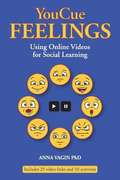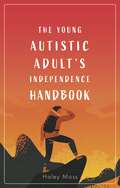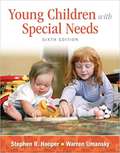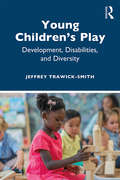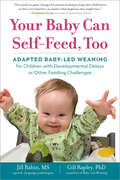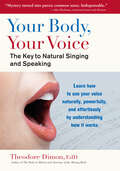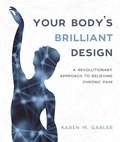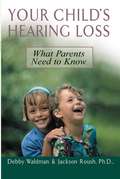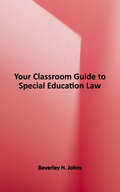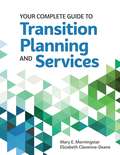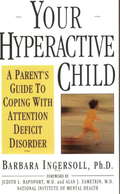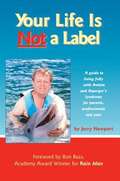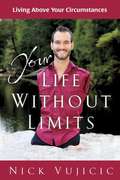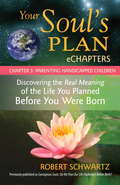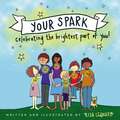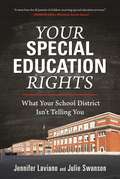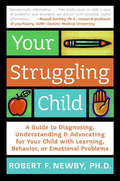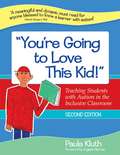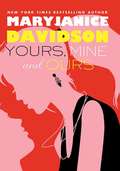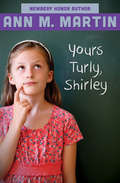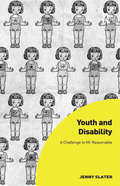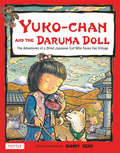- Table View
- List View
YouCue Feelings: Using Online Videos for Social Learning
by Anna VaginFeelings are a crucial element of social relationships, yet students with social learning challenges (some with diagnoses such as Autism Spectrum, Social Communication Disorder or ADHD) frequently have limited understanding of emotions. Our goal for students with such challenges is for them to acquire social relationship skills that will improve their capacity for effective, fulfilling relationships with family members, people at their school or work, and members of their broader community. This is a large and complicated task. YouCue Feelings simplifies such learning using a relatively new form of storytelling - online videos - to accelerate learning about feelings and relationships. YouCue Feelings includes summaries and titles of 25 wonderful online, easily accessed videos. Each has been selected for its portrayal of rich social relationships and crucial social learning concepts. YouCue Activities, done in conjunction with video viewing, make up the core of the YouCue Feelings program. These activities range from simple drawing projects or discussions about the characters in a YouTube video, to more sophisticated activities such as building connections between the social learning concepts in videos and what happens in a student's everyday life.
The Young Autistic Adult's Independence Handbook
by Haley MossAre you living away from home for the first time, graduating from school or perhaps getting a new job? These transitions can be especially overwhelming to deal with as a young autistic adult. This survival guide is bursting with neurodivergent-friendly advice from autistic people themselves (and a few neurotypicals too) for young adults embarking on their own journeys of self-discovery and independence. From guidance on organising your own money, looking after your home and organising your social life to tips on self-advocacy and important life skills such as driving, voting and volunteering, Haley Moss has you covered.Using personal stories, interviews with experts and tips from other young people, this book gives you tips and tools to boost your confidence, ready to make your mark on the world!
Young Children with Special Needs
by Warren Umansky Stephen HooperUnderstand typical child development from birth to five and how children with special needs develop differently. Explore six core developmental domains including: gross motor, fine motor and oral motor development, self-care, cognitive development, communication development, and social and emotional development. Read contributions from a variety of experts, each one explaining the latest early intervention strategies within their area of specialty. Learn the process of assessment and intervention and develop universal skills that best support children and their families. Study cases and discuss successful intervention and assessment methods.
Young Children's Play: Development, Disabilities, and Diversity
by Jeffrey Trawick-SmithYoung Children’s Play: Development, Disabilities, and Diversity is an accessible, comprehensive introduction to play and development from birth to age 8 years that introduces readers to various play types and strategies and helps them determine when intervention might be needed. Skillfully addressing both typically developing children and those with special needs in a single volume, this book covers dramatic play, blocks, games, motor play, artistic play, and non-traditional play forms, such as humor, rough and tumble play, and more. Designed to support contemporary classrooms, this text deliberately interweaves practical strategies for understanding and supporting the play of children with specific disabilities (e.g. autism, Down syndrome, or physically challenging conditions) and those of diverse cultural backgrounds into every chapter. In sections divided by age group, Trawick-Smith explores strategies for engaging children with specific special needs, multicultural backgrounds, and incorporating adult–child play and play intervention. Emphasizing diversity in play behaviors, each chapter includes vignettes featuring children’s play and teacher interactions in classrooms to illustrate core concepts in action. Filled with research-based applications for professional practice, this text is an essential resource for students of early childhood and special education, as well as teachers and coaches supporting early grades or inclusive classrooms.
Young Miles (Miles Vorkosigan)
by Lois Mcmaster Bujold3 stories: The Warrior's Apprentice, The Mountains of Mourning, and The Vor Game. More adventures of Miles Vorkosigan aka Admiral Naismith.
Your Baby Can Self-Feed, Too: Adapted Baby-led Weaning For Children With Developmental Delays Or Other Feeding Challenges (The Authoritative Baby-Led Weaning Series #0)
by Jill Rabin Gill RapleyNo matter what challenges they face, your baby can self-feed, too! One in four children has feeding challenges and difficulty eating. If your child is one of them, mealtimes may be a struggle. Whether the reason is neurodiversity (such as Down syndrome), feeding aversion, or a medical condition, feeding therapist Jill Rabin and baby-led weaning pioneer Gill Rapley are here to help with a groundbreaking new approach for parents, caregivers, and health professionals alike: adapted baby-led weaning (ABLW). Find out how to: Respond to your baby’s signals and appetite—and trust their abilities. Improve your baby’s chewing, posture, sensory development, and fine motor skills. Use “bridge devices,” like silicone feeders, to encourage independent eating. Support your baby to eat real, healthy food and enjoy mealtimes with the rest of the family.
Your Body, Your Voice: The Key to Natural Singing and Speaking
by Theodore DimonIn this innovative book, Theodore Dimon, EdD, shows how each part of the vocal organ (breathing, larynx, throat, and so on) works as part of a larger musculoskeletal system that is often interfered with, and how identifying this larger system and understanding in a practical way how it works allows a person to train and improve the voice, whether speaking or singing. Traditional vocal training methods, says Dimon, cannot be effective without restoring the functioning of the musculature that supports the voice. Enhanced with over 50 detailed full-color illustrations, the book discusses the fallacy of traditional breathing exercises and explains that the key to efficient breathing lies in the expansive support of the trunk and rib cage. Investigating the elements needed to produce a strong supported tone, Dimon describes the importance of voice &“placement,&” or directing the sound to a part of the body in order to produce a fully rounded, resonant tone. He identifies harmful patterns of speech and singing, and offers helpful methods for reestablishing the natural function of the vocal mechanism. Individual chapters cover elements of the whispered &“ah,&” producing a pure sung tone, vocal registers, the suspensory muscles of the larynx, and more.
Your Body's Brilliant Design: A Revolutionary Approach to Relieving Chronic Pain
by Karen GablerWant to know the key to eliminating chronic pain from your life? It’s not more rigorous exercise, medical interventions, or expensive therapies. It turns out you have had the key all along—your body and its natural brilliant design!For years we have been overlooking a crucial element of the body—fascia—that holds the key to allowing you to live pain-free. Many of us think of the human body as a static, mechanical system of muscles attached to a skeleton. What is missing from this picture is the tissue that unites all the parts: the fascia, a seamless web of dynamic connective tissue that surrounds all muscles, bones, organs, and even cells. When one part of the fluid fascial web moves, the rest of the body responds. When we learn how to connect to this system through subtle movements, we open up a world of understanding of how our bodies are designed to work with us, not against us, to support an easy and pain-free life.This book will teach you how to feel and embody this new anatomy by connecting to your dynamic center of gravity, or the Core Hug, and to a vertical line of muscles and fascia that runs deep through the body: the Vertical Core. When you connect to the Core Hug and the deep Vertical Core using movement, your body is able to suspend itself and sustain that suspension over time.Your body is already brilliantly designed to support you. The architecture is within you. The key is to access that brilliant design and work with it. Through stunning imagery and simple movement techniques, this book teaches you how to use the natural architecture of your body (bones, fascia, and movement) to align, balance, and support you so that you can move with ease and live without pain.
Your Child's Hearing Loss: What Parents Need to Know
by Debby Waldman Jackson RoushFrom a mother whose daughter has hearing loss, and an audiologist with more than twenty-five years of experience with deaf and hard-of-hearing children and their families, this comprehensive volume offers parents what they need to know from day-to-day practical solutions to technical information to emotional support.
Your Classroom Guide to Special Education Law
by Beverley H. JohnsWhen you're teaching students who have special needs, what are your legal responsibilities? How can you provide appropriate, legally compliant special education services--and avoid pitfalls that could lead to due process hearings and court dates? Turn to this interactive quick guide for concise, accessible answers. The antidote to thick, cumbersome legal volumes, this book gives educators and administrators the basics of special education law in an engaging, easy-to-read format. With the jargon-free definitions and reader-friendly descriptions of laws and court cases, you (TM)II build a storehouse of knowledge you can apply in your classroom. And with the thought-provoking activities and real-life scenarios in each chapter, you (TM)II see law-abiding practices in action and put your knowledge to the test so you're ready to fulfill your important responsibilities. An essential addition to every teacher's professional library--and an ideal supplementary text for teachers in training--this guidebook will help you adhere to the law as you teach students with disabilities and special health care needs.
Your Complete Guide to Transition Planning and Services
by Mary E. Morningstar Beth Clavenna-DeaneThe book synthesizes evidence-based strategies and suggestions for best practice with vignettes and Tips for Transition. This resource includes forms to help special educators and transition coordinators plan activities and instruction, develop transition goals and IEPs, identifying post-school goals, and more.
Your Hour
by M. RaymondFather Raymond, a Trappist monk, tells several stories of people who have always had deep faith in God's love and mercy, or who have come to know God through suffering and meditation. Each story is a beautiful and thought-provoking meditation on life and the afterlife.
Your Hyperactive Child
by Barbara IngersollThe authoritative and up-to-date handbook provides a wealth of urgently needed information to help parents of a hyperactive child understand and cope with their child's baffling behavior.
Your Life is Not A Label
by Jerry NewportThis book describes Jerry's life and how he dealt with the challenges of Asperger syndrome. It also lets you, the reader know of things you should and shouldn't do, as well as Jerry's mistakes.
Your Life Without Limits (10-pk): Living Above Your Circumstances
by Nick Vujicic"As a teenager Nick Vujicic wondered how he ever could have a "normal life." Born without arms and legs, Nick questioned how he would finish school, find a job, enjoy relationships, and not be a burden to others. He even contemplated suicide before realizing that his challenges did not need to limit his life." In this book, the author encourages people to move forward despite the problems and limitations they have in order to reach their full potentials and live the lives that God meant them to live. He urges people to reach out to others for support when things get difficult for them. As he inspires others to live their lives, he wants his readers to encourage others to do the same. "Look for Nick Vujicic's inspiring story in his full-length books Life Without Limits and Unstoppable."
Your Soul's Plan eChapters - Chapter 3: Parenting Handicapped Children
by Robert SchwartzWould you like to understand the deeper spiritual meaning of parenting children who have Asperger's, bipolar disorder, severe autism, Attention Deficit Disorder or ADD, blindness, and other handicaps? Your Soul's Plan eChapters: Parenting Handicapped Children contains the Preface, Introduction, Chapter 1: Pre-birth Planning, and Chapter 3: Parenting Handicapped Children from Robert Schwartz's best-selling spirituality book, Your Soul's Plan: Discovering the Real Meaning of the Life You Planned Before You Were Born. This special eChapter tells the true story of Jennifer, who planned to have two handicapped sons, one with Asperger's Syndrome, bipolar disorder, and Attention Deficit Disorder, the other with severe autism and blindness, and it explains why together she and her sons courageously made this choice before any of them were born. Before birth we ourselves plan great challenges in order to foster our own spiritual growth and the growth of the people we love. This inspirational, healing, and deeply thought-provoking eChapter speaks to our heartfelt desire to know: Why are children born with, or why do they develop, handicaps? What is the spiritual purpose of the handicap for both the parents and the children? What can the parents and children learn, and how can they grow, as a result of the experience? In this eChapter Jennifer shares her personal story, then has sessions with two gifted mediums in which Schwartz asks Spirit, "Were the handicaps planned before birth, and if so, why?" The great love and wisdom that come forth from "the other side" help us to understand the deeper spiritual purposes served by the handicaps. If you are parenting a handicapped child, an awareness of pre-birth planning will empower you to transform any feelings of victimization, anger, sadness, or confusion into acceptance, understanding, and peace. You will develop a deeper knowing of your and your child's courage, greatness, and love for each other as eternal souls. The full edition of Your Soul's Plan also explores the pre-birth planning of physical illness, deafness, blindness, drug addiction, alcoholism, the death of a loved one, and severe accidents. Individual Your Soul's Plan eChapters are available under the following titles: Physical Illness; Drug Addiction and Alcoholism; and Death of a Loved One.
Your Spark: Celebrating the Brightest Part of You!
by Lisa LeonardWe all have a light inside us that shines brightly and makes us who we are. Artists and athletes, dancers and dreamers, jokers and gymnasts … I want to see you shine in your own unique way. Come along with me as we celebrate your spark.Did you know that God gave you your very own spark? It&’s true! And no one else in the whole wide world has a spark like yours! Your spark makes your eyes twinkle and your mouth smile. It makes your feet stomp and your voice loud. It makes you excited and curious to learn new things. It lights you up from the inside, and it fills you with wonder and dreams.Your spark does all that and more. And author Lisa Leonard offers this picture book in celebration of you … and your spark! Lisa pours her heart into this book, bringing Your Spark to life with inspiring text and free-spirited illustrations. More than anything, Lisa wants you and children everywhere to know:Inside your heart there is a spark. It shines bright and true, and it&’s what makes you, YOU!Your Spark:Is written by social media sensation and jewelry-maker Lisa LeonardShines with the universal message of self-acceptance and is a celebration of what makes us all uniqueInspires children to shine in their own unique way
Your Special Education Rights: What Your School District Isn't Telling You
by Jennifer Laviano Julie SwansonDrawing on decades of experience, Jennifer Laviano, a high-profile special education attorney, and Julie Swanson, a sought-after special education advocate, help parents of students with disabilities navigate their school systems to get the services they need for their children.Parents will find no other book on special education like Your Special Education Rights. Julie and Jennifer demystify the federal laws that govern the rights of public school children with disabilities and explain how school districts often ignore or circumvent these laws. They pull the curtain back on the politics of special education, exposing truths that school districts don’t want you to know, such as the fact that teachers are often under extraordinary pressure not to spend resources on services.Most importantly, they outline the central rights you and your child have regarding your child’s education. Did you know that you can refer your child for a special education evaluation? That you can ask for a second opinion if you disagree with the results of some or all of the testing? That you are entitled to parent counseling, training, and more?They also show you how to take that knowledge and apply it to advocating for your child. Here’s what you need to know about the paperwork you will have to complete, detailed information on how to advocate for your child and how to craft language in documents that benefit your child, and more.Filled with vital information and invaluable resources, Your Special Education Rights gives you the information you need to help your child succeed in school and beyond.
Your Struggling Child: A Guide to Diagnosing, Understanding, and Advocating for Your Child with Learning, Behavior, or Emotional Problem
by Robert F. Newby Lynn SonbergHere is a practical, compassionate book parents can turn to when they first recognize that their child has a "problem" -- but aren't sure what it is or where to seek help. At this very moment, millions of children across the U.S. are falling behind in school, acting out impulsively at home, having problems making friends, suffering dramatic mood swings, and more. Their parents are frustrated and afraid, aware that something's wrong, but not sure where to turn for help or how to cope with their child's behavior. "Is it a learning disorder, ADHD, anxiety disorder, or some combination?" they wonder. "Are these moods and behaviors normal or abnormal? Will my child outgrow them?" This book by a noted neuropsychologist explains the different and overlapping symptoms of learning, mood, and behavior disorders and guides parents in getting the right diagnosis and treatment. Dr. Newby demystifies the process and empowers parents. Step by step, he explains: --How to observe and chart your child's behavior--a critical diagnostic tool --What to expect during the evaluation and treatment process --How to partner with medical and school professionals to assist your child and what to do when conflicts arise Clear and comprehensive, this supportive guide will be every parent's first line of defense in helping a troubled child.
You're Going to Love This Kid! Teaching Students with Autism in the Inclusive Classroom (2nd Edition)
by Paula KluthIntended for teachers, this practical guide explains how to plan inclusive lessons, engineer a safe and comfortable classroom, provide communication opportunities, teach reading and writing, and support challenging behaviors. The second edition adds reproducible forms, checklists, charts, black and white photographs, figures, and space for taking notes. Annotation ©2010 Book News, Inc. , Portland, OR (booknews. com)
Yours, Mine, and Ours (BOFFO, Book #2)
by Maryjanice DavidsonFrom New York Times bestselling author MaryJanice Davidson comes the next hilarious installment in her laugh-out-loud trilogy featuring an unconventional FBI agent who finds love in the most unexpected places It's Christmas season, a holiday Cadence adores. Her relationship with Patrick has been progressing nicely, and they are beginning to wonder if it might be time to bring things to the next level --unprecedented in Cadence's life. That is until she meets the completely dreamy Dr. Max Gallo and he throws Cadence and her sisters for a tailspin. And if the threat of Dr. McDreamy weren't enough there is a new BOFFO employee, Emma Jan Thyme, whose reputation precedes her. She has a doctorate from Harvard, speaks seven languages, and is a remarkable actress. But she's harboring a secret of her own. In addition to adjusting to a new co-worker's foibles, shopping for her Secret Santa, and trying to find the perfect Christmas gift for Patrick, a new serial killer appears to have blown into town. For four Junes in a row perfectly ordinary fourteen year olds have disappeared. The only things the victims have in common are their ordinariness-- and it's up to Cadence to figure out the case before another innocent teen dies.
Yours Turly, Shirley
by Ann M. MartinSurviving fourth grade isn&’t going to be easy for Shirley—but the thought of repeating it with her younger sister is too much to bearShirley Basini is dreading fourth grade—if she doesn&’t do well this year, she&’ll be held back. Having dyslexia is tough, but having a brilliant older brother makes it even worse. When Shirley&’s parents adopt a young girl from Vietnam, she&’s excited to have someone whom, for once, she can teach some things.But her new sister is actually quite adept at English and winds up in the advanced third-grade class. Shirley can&’t face the prospect of repeating fourth grade—this time with her adopted sister, who might even perform better than she does. Shirley has only one talent that might prove she&’s not dumb—but does she have the will to let it shine?This ebook features an illustrated personal history of Ann M. Martin, including rare images from the author&’s collection.
Youth and Disability: A Challenge to Mr Reasonable (Interdisciplinary Disability Studies)
by Jenny SlaterIn this ground-breaking book, Jenny Slater uses the lens of ’the reasonable’ to explore how normative understandings of youth, dis/ability and the intersecting identities of gender and sexuality impact upon the lives of young dis/abled people. Although youth and disability have separately been thought within socio-cultural frameworks, rarely have sociological studies of ’youth’ and ’disability’ been brought together. By taking an interdisciplinary, critical disability studies approach to explore the socio-cultural concepts of ’youth’ and ’disability’ alongside one-another, Slater convincingly demonstrates that ’youth’ and ’disability’ have been conceptualised within medical/psychological frameworks for too long. With chapters focusing on access and youth culture, independence, autonomy and disabled people’s movements, and the body, gender and sexuality, this volume’s intersectional and transdisciplinary engagement with social theory offers a significant contribution to existing theoretical and empirical literature and knowledges around disability and youth. Indeed, through highlighting the ableism of adulthood and the falsity of conceptualising youth as a time of becoming-independent-adult, the need to shift approaches to research around dis/abled youth is one of the main themes of the book. This book therefore is a provocation to rethink what is implicit about ’youth’ and ’disability’. Moreover, through such an endeavour, this book sits as a challenge to Mr Reasonable.
Youth with Cultural/Language Differences: Interpreting an Alien World
by Kenneth Mcintosh Ida WalkerTanya Begay hates life in Los Angeles, so different from Navajo Nation where she grew up. At her grandfather's urging, she tries to help others in the city--including an Afghan immigrant struggling to learn English and a Guatemalan girl caught up in gang violence. The lives of these three girls from three different cultures collide, changing each of their destinies. Along the way, they learn a whole lot about themselves and their cultures, their differences and their similarities.
Yuko-chan and the Daruma Doll: The Adventures of a Blind Japanese Girl Who saves Her Village
by Sunny SekiYuko-chan and the Daruma Doll, a gorgeous multicultural children's book by author/illustrator Sunny Seki, takes readers on a journey into ancient Japan and the story behind the famous Daruma Doll.<P><P>Yuko-chan, an adventurous blind orphan, is able to do amazing things. She confronts a burglar in the dead of night, and crosses treacherous mountain passes to deliver food to hungry people. During her travels, Yuko-chan trips and tumbles down a snowy cliff. She discovers a strange thing as she waits for help: her tea gourd, regardless of how she drops it, always lands right-side-up. The tea has frozen in the bottom of the gourd! Inspired by this, she creates the famous Daruma doll toy, which rights itself when tipped--a true symbol of resilience.Thanks to Yuko-chan's invention, the villagers are able to earn a living and feed themselves by selling the dolls. Yuko-chan never gave up, no matter the obstacles she faced, and the Daruma doll is a charming reminder of the power of perseverance.
